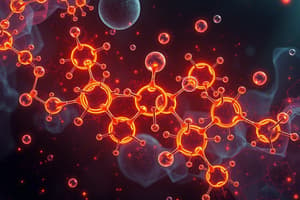Podcast
Questions and Answers
How is the presence of aromatic character typically determined in compounds?
How is the presence of aromatic character typically determined in compounds?
- By assessing the color of the compound
- By examining the molecular weight of the compound
- By checking for the number of hydrogen atoms in the compound
- By analyzing the presence of alternating double and single bonds at the boundary (correct)
Why is it crucial to consider electron counts when determining aromaticity in compounds?
Why is it crucial to consider electron counts when determining aromaticity in compounds?
- To identify the presence of heavy metals
- To predict the color of the compound
- To determine the boiling point of the compound
- To establish the aromatic or antiaromatic nature of the compound (correct)
What was used as an example to explain planar and non-planar iron centers in molecules?
What was used as an example to explain planar and non-planar iron centers in molecules?
- Hemoglobin (correct)
- Iron oxide
- Oxygen molecule
- Naphthalene
In the context of aromatic compounds, what is the significance of continuous conjugation at the boundary?
In the context of aromatic compounds, what is the significance of continuous conjugation at the boundary?
What process involves rotating double bonds to align with the boundary for determining aromaticity?
What process involves rotating double bonds to align with the boundary for determining aromaticity?
What role does batch size optimization play in understanding aromaticity?
What role does batch size optimization play in understanding aromaticity?
What distinguishes antiaromatic compounds from aromatic and non-aromatic compounds?
What distinguishes antiaromatic compounds from aromatic and non-aromatic compounds?
How does the example of hemoglobin illustrate the concept of planar and non-planar iron centers?
How does the example of hemoglobin illustrate the concept of planar and non-planar iron centers?
Why is it important to check for alternating double bonds after a single bond gap in identifying aromatic compounds?
Why is it important to check for alternating double bonds after a single bond gap in identifying aromatic compounds?
What is the primary purpose of rotating double bonds for aromaticity determination?
What is the primary purpose of rotating double bonds for aromaticity determination?
How does the presence of continuous conjugation at the boundary affect the aromatic character of a compound?
How does the presence of continuous conjugation at the boundary affect the aromatic character of a compound?
What distinguishes the iron coordination environment in aromatic compounds from antiaromatic and non-aromatic compounds?
What distinguishes the iron coordination environment in aromatic compounds from antiaromatic and non-aromatic compounds?
How does the compound naphthalene illustrate the concept of aromaticity?
How does the compound naphthalene illustrate the concept of aromaticity?
Flashcards are hidden until you start studying
Study Notes
- Last class, the speaker discussed aromatic compounds and the distinction between antiaromatic, aromatic, and non-aromatic compounds.
- A specific example of a compound named naphthalene was given to illustrate the concept of aromaticity.
- The discussion involved shifting students between batches to optimize learning conditions, with a focus on batch sizes and attention levels.
- The speaker highlighted the importance of checking the boundary for the presence of alternate double and single bonds to determine aromaticity.
- The example of hemoglobin was used to explain the concept of planar and non-planar iron centers in molecules.
- The speaker emphasized the significance of electron counts in determining aromaticity or antiaromaticity in compounds.
- The process of rotating double bonds to align with the boundary for aromaticity determination was demonstrated.
- The discussion also touched upon the analysis of iron oxidation states and coordination environments in molecular structures.
- The importance of checking for alternating double bonds after a single bond gap to identify aromatic compounds was stressed.
- The presence of continuous conjugation at the boundary was highlighted as a key indicator of aromatic character.
Studying That Suits You
Use AI to generate personalized quizzes and flashcards to suit your learning preferences.




